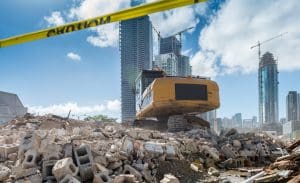Over 50% of landfills worldwide are filled with construction waste. An international project, led by Northumbria University in partnership with Saudi Arabia’s King Fahd University, is looking to leverage AI to quantify construction waste onsite and provide additional value to circular economy frameworks to reduce the amount going to landfill
Construction waste is a national and global problem. The UK construction industry is responsible for the use of about 40% of raw resources every year (stone, gravel, wood and sand), of which about 20% ends up in landfills, contributing to 23% of all air pollution and about 40% of water pollution.
Waste reduction in the construction industry is key for any country aiming to achieve the UN sustainability goals marked for 2030, especially around sustainable consumption and production patterns.
Current efforts have managed to divert about 13% of it from landfills by looking for alternative ways of disposal or finding novel uses for certain materials found in construction waste. However, that is still far from the 99% goal set up for the near future.
Saudi Arabia faces similar challenges, with the increased difficulty of a rapidly developing economy hindering sustainability for economic growth.
According to Saudi Arabia’s National Center for Waste Management, the environmental degradation caused by solid waste in 2021 was estimated at $1.3bn. Waste generated by the construction industry in Saudi Arabia amounts to about 130m tonnes a year, of which less than 1% is recycled. The rest mostly ends up in landfills. Landfill demand is very high at about 28m m³ per year.
Overall, both countries require critical action to meet sustainability goals regarding waste reduction, mitigating environmental impact and achieving circular economy within the construction sector to reduce the pressure on landfills.

Developing an AI-based approach to quantify construction waste
The construction industry lacks a reliable tool that quantifies how much of each type of waste is being generated in their project, beyond modelling estimations in BIM. This lack of real-time information impedes proper planning around sustainable goals of reducing waste. This is critical, especially as tonnes of recyclable and reusable construction materials end up in landfills.
For that, a visual system is envisioned to capture the waste generated in a construction site on their temporary storage collection points. Video recordings of waste being introduced into the collection points, ie skips, loaders etc, will be the base of this technology.
This system is designed as a plug-and-play system, increasing the flexibility and capabilities of the data capture process, maximising our data capture capacity moving from site-to-site locations and around sites.
Then, using the captured data as the knowledge base, artificial intelligence models will be trained and validated to identify waste types, focusing on recyclable materials such as wood or plastics, and estimating the accumulated weight of the waste generated per class.
As such, a clear audit of waste can be attributed to each collection point, reporting on waste generation at a granular level, enabling data visualisation, deeper analysis on waste mitigation efforts and identifying patterns that enable waste reduction and circular economy practices.
Delivering transformation through site-evaluated research
To transform the current landscape of waste generation at construction sites, the British Council has generously funded an international team of researchers from Northumbria University at Newcastle and Saudi Arabia’s King Fahd University.
They are embarked in a year-long venture to design, create and test the AI system across multiple construction sites and project use cases, from schools or residential estates to office buildings. The goal is to provide a comprehensive view of waste generation across multiple project types in an international context.
This project has support from the International Centre for Connected Construction (IC3) and Wates Group, which will allow access to current and future UK-based construction sites to quantify construction waste and evaluate practice against regulatory requirements.
Wates takes a holistic approach to sustainability in the built environment and is working towards becoming a net zero carbon company by 2045. Passionate about eliminating carbon and waste from its operations and improving the natural environment, the company is on a mission to create a cleaner, greener and safer world for future generations.
Wates’ commitment to decarbonisation is built around the three core tenets of: building for the future, maintaining buildings for the long term and using data to continuously monitor performance.
Working in partnership with its specialist engineering services team, SES, it is always exploring the latest technology and innovative solutions to improve the experience for customers and end users, and drive change across the industry.
As such, the research team will elaborate a comparative analysis between waste generated and resources usage, construction practice, sustainability goals at national and organisational levels, as well as regulations will be performed to highlight good practices and identify areas for improvement.
To this end, the data-driven approach hopes to push sustainable construction goals through evidence-based research and highlighting construction waste value.

Transforming construction waste into a resource
This project hopes to evidence the capacity of the construction industry to deal with its waste in different ways, embracing circular economy frameworks and enhancing waste management practices.
Driven by a vision in which construction waste becomes a steady supply chain of materials towards recycling or waste to energy industries, to name a few, this project will deliver the technological capacity and a clear framework for the construction industry to advance towards that goal.
This is an exciting opportunity for the UK construction community to collaborate towards a data-driven solution to sustainable construction goals. Doing so now will significantly change the paradigm of waste management in construction sites and reintroducing many raw resources back into the UK industry, generating revenue while reducing environmental impact.

